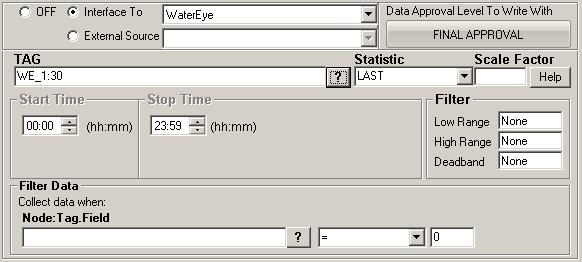Supported variable configurations for the Hach WIMS Direct Server-Side Interface to WaterEye Database.
To link a variable to a WaterEye sensor, select Edit/View Variables in the client and select the Interface tab.
Then click Interface To radio button. The drop down box next to the option is now enabled, click the drop down arrow and choose the WaterEye interface name (name given when configuring the interface).

Now you are ready to link a variale to a WaterEye sensor. The Tag name and a statistic are all that are mandatory.
 This is the tag name that will be used to link this variable to a WaterEye sensor. The ? symbol (question mark) will allow you to browse for tag names.
This is the tag name that will be used to link this variable to a WaterEye sensor. The ? symbol (question mark) will allow you to browse for tag names.
 This is a listing of all the statistics supported by this interface. This includes the following statistics for a specified time period:
This is a listing of all the statistics supported by this interface. This includes the following statistics for a specified time period:
| AVERAGE |
Take the average of the data poins |
| TOTAL |
Take the sum total of all values |
| MINIMUM |
Get the minimum value |
| MAXIMUM |
Get the maximum value |
| FIRST |
Get the first value |
| LAST |
Get the last value |
| DIFF |
Calculate the difference between the first value and the last value |
| RANGE |
Calculates the difference between the minimum and maximum values |
| INVENTORY |
This is a count of all the values in the file, when the value decreases from previous value and the decrease is greater than the DEADBAND set in Hach WIMS client for the variable |
| COUNT |
Get the number of records |
| TIMEGT(x) |
Get the number of records with values greater than (x), i.e. TIMEGT(5) would count all values > 5 |
| TIMELT(x) |
Get the number of records with values less than (x) |
| TIMEEQ(x) |
Get the number of records with values equal to (x) |
 This is the value to multiply the result by when using parameter variable types. Commonly used to convert from one unit base to another. For example to convert gallons per minute (GPM) to gallons per day (GPD), set the scale factor to 1440 (1440 minutes per day).
This is the value to multiply the result by when using parameter variable types. Commonly used to convert from one unit base to another. For example to convert gallons per minute (GPM) to gallons per day (GPD), set the scale factor to 1440 (1440 minutes per day).
 All three fields must have numeric values or the word None (as shown). The Low Range and High Range will crop data from the source. For example to eliminate negative numbers from a particular tag, set the Low Range to 0 (zero) - this will get any values equal to or greater than 0 (zero). The Deadband is used for the statistic Inventory and will elliminate noise levels up to the value specified. For example, if you enter .5 next to Deadband, any value change of .5 or less, will be ignored.
All three fields must have numeric values or the word None (as shown). The Low Range and High Range will crop data from the source. For example to eliminate negative numbers from a particular tag, set the Low Range to 0 (zero) - this will get any values equal to or greater than 0 (zero). The Deadband is used for the statistic Inventory and will elliminate noise levels up to the value specified. For example, if you enter .5 next to Deadband, any value change of .5 or less, will be ignored.

- Start Time will set the beginning of the time slot for this variable.
- Stop Time will set the ending time for the time slot.
- Same Day as Start is only used by daily variables and it means the stop time is on the same day as the start time.
- Day After Start is also only used by daily variables and it means the stop time is a day after the start time.

- Using the Filter Data feature allows you to collect data for the current variable only when certain conditions are met on another tag/sensor. For example, if you wanted to collect the Filtered Turbidity only when the Flow was greater than 0, you can configure that here.